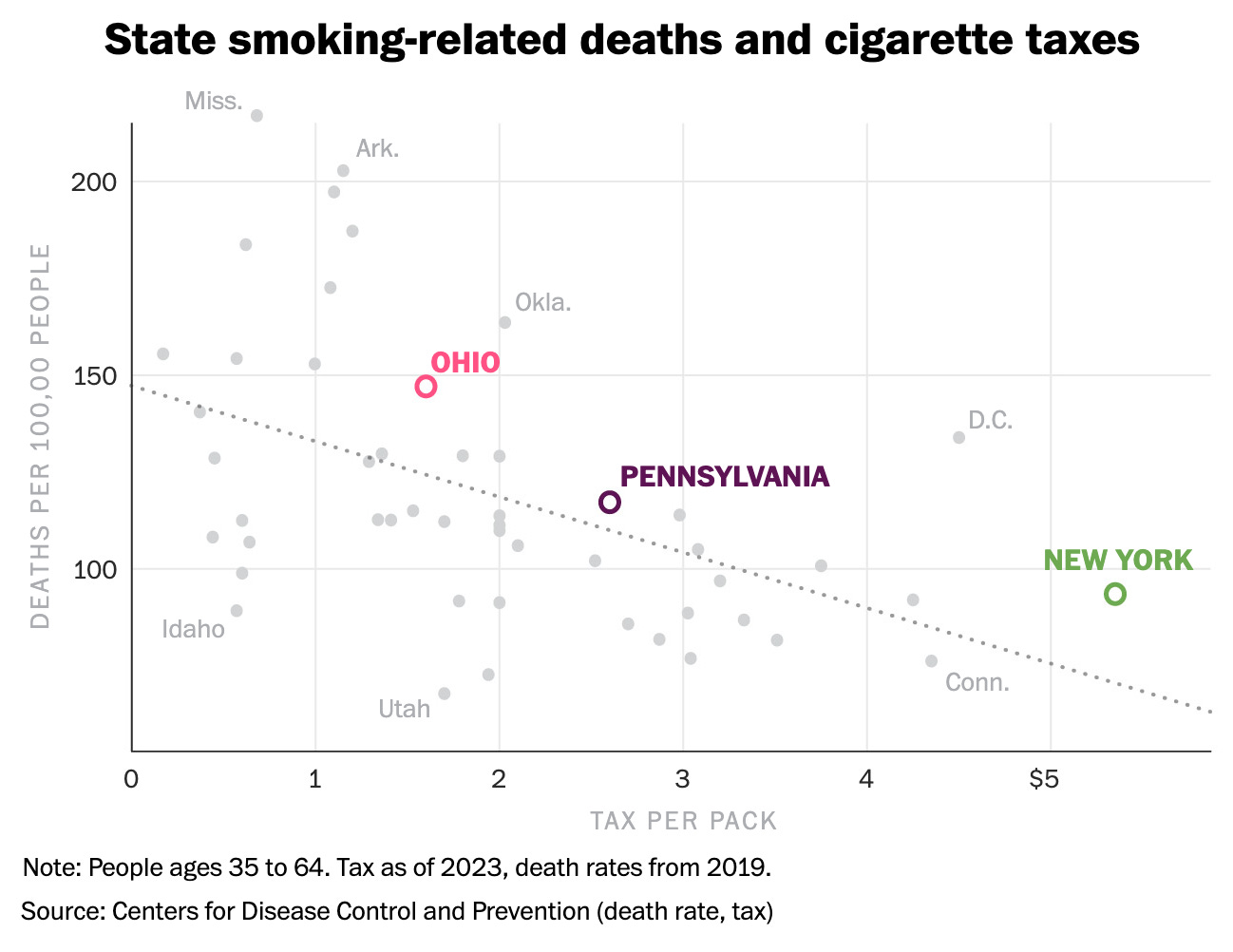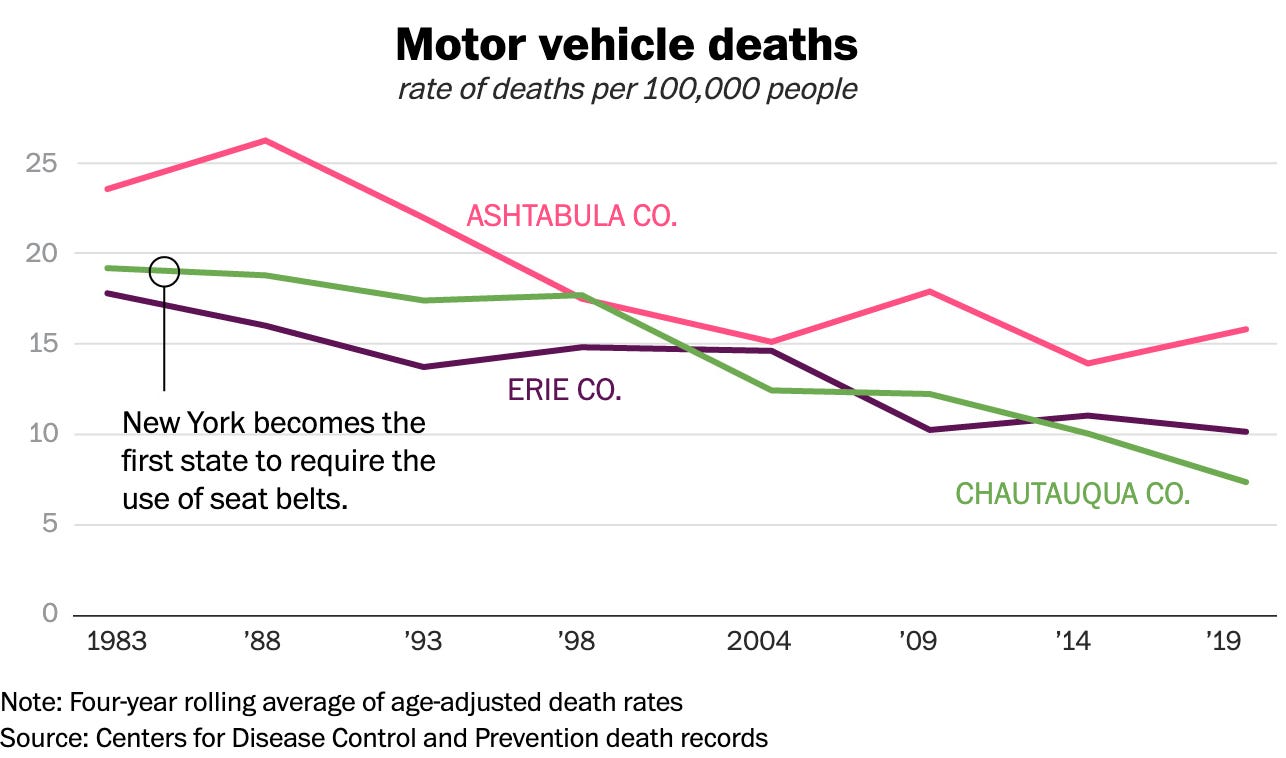Hey, guess what, y'all? Republicans really ARE trying to kill you!!
And they're not being particularly subtle about it.
In keeping silent about evil, in burying it so deep within us that no sign of it appears on the surface, we are implanting it, and it will rise up a thousand fold in the future. When we neither punish nor reproach evildoers, we are not simply protecting their trivial old age, we are thereby ripping the foundations of justice from beneath new generations.
Aleksandr I. Solzhenitsyn, The Gulag Archipelago 1918–1956
It’s easy to complain about Republican policies (or lack of same) and the damage we see them doing to America, and there’s little doubt that the GOP and its self-interested politics ARE doing real damage to this country. But it’s one thing to make an argument anecdotally, even one that seems quite clear. It’s another to be able to use scientific data that shows the genuine problems created by Republicans. It’s even worse when those problems result in the increased loss of human lives due to the self-interest and short-sighted views of GOP politicians, who often refuse to acknowledge what the data in front of them is screaming.
The risks to human life and health are becoming increasingly difficult to ignore, yet that’s precisely what’s happening in Ohio, a deeply red state distrustful of science and Big Government.
Americans are more likely to die before age 65 than residents of similar nations, despite living in a country that spends substantially more per person on health care than its peers.
Many of those early deaths can be traced to decisions made years ago by local and state lawmakers over whether to implement cigarette taxes, invest in public health or tighten seat-belt regulations, among other policies, an examination by The Washington Post found. States’ politics — and their resulting policies — are shaving years off American lives.
In other words, Republican legislators, who could pass laws to change this cycle, are shirking their duty to protect their constituents. And their constituents appear to be fully on board with it because they keep electing those disinclined to protect them.
The Washington Post spent months comparing the impact of laws and policies in three counties along Lake Erie- Ashtabula in Ohio, Erie in Pennsylvania, and Chautauqua in New York. What they learned about Republican dereliction of duty is distressing.
It made for a stark comparison because Ashtabula County is part of a state whose political culture is diametrically opposed to more Liberal Pennsylvania New York…and the results show in the death statistics.
Ashtabula’s problems stand out compared with two nearby counties — Erie, Pa., and Chautauqua, N.Y. All three communities, which ring picturesque Lake Erie and are a short drive from each other, have struggled economically in recent decades as industrial jobs withered — conditions that contribute toward rising midlife mortality, research shows. None is a success story when it comes to health. But Ashtabula residents are much more likely to die young, especially from smoking, diabetes-related complications or motor vehicle accidents, than people living in its sister counties in Pennsylvania and New York, states that have adopted more stringent public health measures.
Keep in mind that Ohio is a red state, while Pennsylvania and New York are blue.
Ohio sticks out — for all the wrong reasons. Roughly 1 in 5 Ohioans will die before they turn 65, according to Montez’s analysis using the state’s 2019 death rates. The state, whose legislature has been increasingly dominated by Republicans, has plummeted nationally when it comes to life expectancy rates, moving from middle of the pack to the bottom fifth of states during the last 50 years, The Post found. Ohioans have a similar life expectancy to residents of Slovakia and Ecuador, relatively poor countries.
None of these three counties have escaped the economic downturns that have hit American heavy industries. The jobs that have gone overseas or disappeared altogether have left behind high unemployment rates and even higher underemployment rates.
The economic upheavals have taken a tremendous toll on all three counties, with high rates of mental health issues, alcoholism, and drug abuse, which Ohio has lagged far behind Pennsylvania and New York in dealing with.
Like other hard-hit Midwestern counties, Ashtabula has seen a rise in what are known as “deaths of despair” — drug overdoses, alcoholism and suicides — prompting federal and state attention in recent years. But here, as well as in most counties across the United States, those types of deaths are far outnumbered by deaths caused by cardiovascular disease, diabetes, smoking-related cancers and other health issues for residents between 35 and 64 years old, The Post found. Between 2015 and 2019, nearly five times as many Ashtabula residents in their prime died of chronic medical conditions as died of overdoses, suicide and all other external causes combined, according to The Post analysis of the Centers for Disease Control and Prevention’s death records.
Public health officials say Ohio could save lives by adopting measures such as a higher tobacco tax or stricter seat-belt rules, initiatives supported by Gov. Mike DeWine, a Republican generally friendly to their cause.
“I told the legislature, ‘I’m going to ask you to invest in things where you’re not going to see the results during your term in office and I’m not going to see it during my term in office,’” DeWine said in an interview in the governor’s mansion.
Gov. DeWine is no one’s idea of a raging, wooly-headed Liberal, but his proposals have languished in a legislature controlled by Republicans for all but two of the past 29 years. Despite the information available to them and the knowledge that their actions could save the lives of Ohioans, Republicans in the legislatures seem disinclined to move forward on Gov. DeWine’s proposals.
Many in the Ohio state legislature view Gov. DeWine, a Republican like most of them, as having a “nanny state” mentality. They don’t think their constituents want Big Government telling them what they can or can’t do, even if it might help to save lives.
To Ohio Republicans, freedom from the oppressive hand of government is far more critical than anything that government can do to preserve the lives of Ohioans.
Yes, that’s every bit as dogmatic and short-sighted as one might think. Still, we’re talking about people like House majority floor leader Bill Seitz, a 68-year-old Republican who smoked for 50 years before losing a kidney to cancer this summer.
[H]e’s unmoved by his own brush with the health system — even if it led him to finally kick the habit.
“I’m not going to turn into a smoke Nazi just because I used to smoke and I don’t anymore,” Seitz said.
Sure, I could use my cancer diagnosis and kidney loss as a learning experience and an opportunity to perhaps spare others the same agony…but why would I? People should be free to make their own decisions. Some people learn from their experiences and use that knowledge to help others avoid that pain and suffering. And others stand by and observe mutely as people they could help (but don’t) fall into the same hole.
Never mind that, ultimately, we all pay the costs associated with cancer and medical treatment associated with long-term smoking. It’s in the public interest to support anti-smoking initiatives and do whatever is possible to educate the public against smoking.
No, “I’m not going to turn into a smoke Nazi….”
Yep- dogmatic, short-sighted, and Republican. Rep. Seitz hit the trifecta…and he’s not alone. He has plenty of company.
Thirty years ago, Ohio’s health outcomes were on par with California’s, with nearly identical death rates for adults in the prime of life — ranking in the middle among the 50 states. But the two states’ outcomes have diverged, along with their political leanings, said Ellen Meara, a health economics and policy professor at the Harvard T.H. Chan School of Public Health. She has studied why death rates fell in California, home to some of the nation’s most progressive politics, while they scarcely budged in increasingly conservative Ohio. By 2017, California had the nation’s second-lowest mortality rates, falling behind only Minnesota; Ohio ranked 41st, according to The Post analysis.
Health disparities also show up unevenly across Ohio. The gleaming towers of the Cleveland Clinic, acclaimed as one of the world’s top hospitals, stand an hour away from Ashtabula, where the average life expectancy in 2018 was 75.1 years — nearly two years lower than the state of Ohio’s average and more than 3½ years shorter than the country’s average….
Many of the state’s public health outcomes are a direct result of political decisions, Skinner and other experts say, pointing to differences in Medicaid and safety net funding, as well as tobacco taxes and highway safety laws between Ohio and its neighbors. They note that Republicans’ stranglehold on the legislature, after defying repeated court orders to redraw state voting maps, has protected those politicians from the consequences of their votes.
The Ohio State Patrol says that the Buckeye State loses around 500 people each year in automobile accidents who weren’t wearing seatbelts. I find this astonishing because the only hard-and-fast rule in my car is that it doesn’t move until everyone is buckled in. It’s just basic common sense…and yet 500 people die in Ohio each year who possibly could’ve survived if they’d exercised the common sense to buckle their seat belts.
There’s no way to say definitively that each of the 500 victims would be alive today if only they’d buckled up, but it would’ve given them a greater chance of survival, one they chose not to avail themselves of. Call it stupidity, natural selection, or senseless, but whatever the case, it shouldn’t happen.
Except that it does in Ohio because the state legislature blocked Gov. DeWine’s proposal to allow police to pull over cars in which drivers or passengers aren’t wearing seatbelts. This issue is personal for the Governor, having lost a daughter in an automobile accident in 1993.
Thirty-five states now allow law enforcement officers to pull over cars where drivers and/or passengers are not/wearing seatbelts. It’s a way to enforce a common-sense safety feature that saves lives. Why Ohio Republicans see it differently is something there’s no rational explanation for.
State data shows that seat-belt use has fallen in Ohio to its lowest level in 18 years — with fewer than 81 percent of residents regularly buckling up, compared with 92 percent of Americans as a whole — worrying officials who say the decline is preventable, inexplicable and contributes to greater risk. A Post analysis shows that Ashtabula residents are twice as likely to die of motor vehicle accidents as are people in Chautauqua.
Another way the Ohio state legislature could make a positive difference would be to increase cigarette taxes.
You can probably imagine what hasn’t happened and what the impact has been.
Ohio’s GOP lawmakers have also rebuffed multiple efforts to boost cigarette taxes, a public health measure proven to decrease smoking rates — especially among new and young smokers. When Gov. John Kasich (R) attempted to raise the cigarette tax by $0.65 per pack in 2017, business lobbyists warned that residents would spend their money elsewhere, with one testifying that “consumers are coming into Ohio to save money on their cigarettes from Pennsylvania.”
The tax increase was defeated.
Today, cigarettes in Ohio are notably cheaper than the same packs sold just over the state line: A Post reporter in June purchased Marlboro Gold — formerly called Marlboro Lights, among the most popular cigarettes — for $9.74 in Ashtabula, $10.35 in Erie and $13 in Chautauqua, the only place where the reporter was required to prove she was at least 21 years old.
At the time, cigarette taxes were $1.60 per pack in Ohio, $2.60 in Pennsylvania and $4.35 in New York. In September, New York, which already boasts one of the highest state cigarette taxes in the nation, raised its tax another $1 per pack.
Not surprisingly, the data bears out the impact of the difference in the tax rates:
Not surprisingly, experts said, Ohio’s smoking rate exceeds that of nearby states with stricter tobacco measures. Almost 21 percent of adults in Ohio smoked in 2019, compared with 17 percent of Pennsylvanians and nearly 13 percent of New Yorkers, according to the CDC.
There’s also a notable difference in health outcomes: Smoking-related deaths — including from lung cancer, heart disease and chronic lower-respiratory disease — have declined sharply across the country over the last two decades but increased in Ashtabula, where middle-aged adults are 55 percent more likely to die of those causes than the national average, The Post found. While the rates of smoking-related deaths in Erie and Chautauqua are grim, they are not nearly as bad as Ashtabula’s.
It’s 2023. There are no questions about the risks of cigarette smoking…and yet Republicans in the Ohio legislature refuse to take action that could materially impact their state’s smoking death rates. They could save lives AND save future generations millions in tax dollars that wouldn’t need to be spent on caring for those with lung cancer.
And Buckeye State Republicans are punting on what should be a no-brainer.
Part of the problem concerns how the state of Ohio has spent- or, more accurately, misspent- their share of the national settlement with tobacco companies in 1998.
Initially, Ohio used the settlement funds as recommended by the Centers for Disease Control (CDC)- to fund anti-smoking and smoking cessation programs. Between 2001-2008, smoking rates in Ohio fell by more than 25%, among the steepest drops in the country.
As the global economic downturn hit in 2008, Ohio’s state government began raiding the settlement funds to pay for other state programs. Then-Gov. Ted Strickland took $230 million from the fund. That led to groups like the Campaign for Tobacco-Free Kids warning that robbing the settlement funds could adversely impact Ohio’s residents.
By 2010, Ohio was one of just three states not spending any settlement money on tobacco prevention, according to the Campaign for Tobacco-Free Kids. The state received $1.2 billion from the tobacco settlement that year, directing the money instead toward initiatives such as building schools and funding children’s health care, as well as shoring up the state budget.
Without the settlement funds being used for the intended purpose, there was no longer an infrastructure for statewide anti-smoking efforts, which did, in fact, have the predicted adverse impact on Ohio residents.
Ohio’s smoking rate began to rise, from 20% in 2008 to 25% in 2011, and the Buckeye State now has one of the highest smoking rates in the country.
Death is a recurring theme in Ashtabula County in a way it isn’t in other places, at least when considering the combination of death rates from preventable deaths…like automobile accidents.
It’s tempting to place the blame for refusing to do the right thing squarely on the shoulders of Republicans in the Ohio state legislature. Ultimately, the blame can be laid at the feet of the Ohio GOP, but they’ve had considerable help getting to where they can refuse to do the right thing.
That assistance too often comes in the form of lobbyists, who can bring pressure and money to bear on circumstances they don’t want to see change because the status quo ante benefits their client(s). Tobacco companies, for instance, don’t want to see higher cigarette taxes. They don’t want to see sales drop; it’s not about lives for them. It’s about maintaining market share.
According to Federal Election Commission records, House majority floor leader Bill Seitz, whom I mentioned earlier, has received $18,500 from tobacco companies since 2004. Does it influence his votes on cigarette tax increases? Rep. Seitz says no and that tobacco companies donate to him because they know he’s on their side.
Who knows? The money certainly doesn’t hurt.
The Post report is quite extensive and goes on to discuss Erie and Chautauqua counties at greater length. For anyone interested in how Republicans have negatively impacted our health, safety, and political system, I’d highly recommend reading the entire piece; it’s well worth it.
My takeaway was that Republicans are trying to kill us, though perhaps not deliberately or directly. Even so, they’re certainly not being particularly subtle, nor are they exercising reasonable degrees of wisdom in their decision-making, which has little to do with the well-being of their constituents.
It’s all about the Benjamins.
(All of my posts are now public. Any reader financial support will be considered pledges- support that’s greatly appreciated but not required to get to all of my work. I’ll leave it to my readers to determine if my work is worthy of their monetary support and at what level. To those who do offer their support, thank you. It means more than you know.)










Thanks for this analysis.